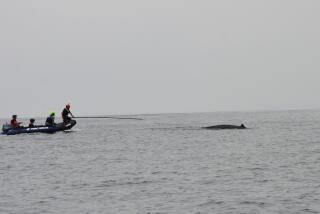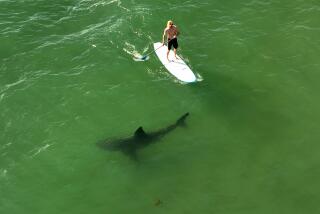Whale Loses Last Links to Rescuers
- Share via
SAN DIEGO — J.J., the California gray whale, won’t be phoning home anymore.
Which means the leviathan-loving public may never know if J.J. survives her unprecedented return to the sea after 14 months of convalescence at the Sea World theme park.
All four transmitters on J.J.’s back, designed to track her movements, have washed ashore, park officials sadly announced Friday.
Researchers had hoped the transmitters would allow them to track J.J.’s location and behavior for 18 months and to post information on a J.J. Web site.
Instead, J.J., the largest mammal ever held in captivity, apparently shook off the two small packages within two days of her release Tuesday off Point Loma. The packages quickly washed ashore, one at Imperial Beach, one at Coronado, both still beeping dutifully.
“Scientifically, we’re all disappointed,” said veterinarian Pam Yochem, senior research biologist at the Hubbs-Sea World Institute. “But we’re still thankful we were involved with the story of this comatose week-old calf who grew into a robust 19,000-pound behemoth and taught us all a lot.”
Although it is a poor substitute for satellite tracking, visual contacts could still allow at least a modicum of information about J.J., officials said.
Sea World has issued a kind of all-points bulletin to other marine researchers, noting J.J.’s distinctive gray, black and white markings, the scar on her tail fluke, and a red, white and blue ribbon attached to her back.
The National Marine Fisheries Service, as part of its long-term research on whales, takes pictures from airplanes patrolling at low levels. In the future, those pictures will be scrutinized for signs of J.J.
There is also a chance J.J. could be spotted by sea lions trained at the Moss Landing research project run by San Jose State. Two of the sea lions were brought to Sea World last year to meet J.J., part of the bounty of scientific research that resulted from J.J.’s life in a 1.7-million-gallon tank. Outfitted with “critter cams,” the sea lions are to be sent out to take pictures of migrating whales.
About 40 hours of data collected from J.J.’s transmitters before they were dislodged will be analyzed and the information posted on the Web site.
Also, listening devices called sonobuoys--like those used by the Navy to detect enemy submarines approaching San Diego--recorded J.J.’s vocalizations, her first attempt at the sounds that whales are thought to use for communication and navigation.
There are plans to cull the vocalizations and create a kind of “J.J.’s Greatest Hits” for the Web site, which has proved particularly popular among schoolchildren captivated by the struggle of the infant abandoned by her mother and left to die.
Since being posted in May, the Web site has received about 8,000 hits a day. On Tuesday, during the four-hour operation to return the 19,200-pound, 31-foot-long animal to her natural environment, the site received more than 1,000 hits a minute.
Yochem and other J.J.-watchers believe J.J. may have dislodged the transmitters while foraging for food. One of the transmitters showed scratches and splintering consistent with being scraped against the ocean floor.
While in the privacy of her own pool, J.J. was known to slide along the bottom and perform barrel rolls.
Researchers had opted not to implant the transmitters beneath J.J.’s blubber--a technique sometimes used with adult whales. Although huge, J.J. is far from full grown--adult female gray whales can weigh 74,000 pounds and stretch 55 feet--and her blubber is only 3 inches thick.
The transmitters were attached to J.J. with shallowly planted toggle bolts made of Kevlar, a material used for bulletproof vests.
“We felt implantation was too invasive,” said Yochem. “I’d much rather be telling you how the transmitters came loose than how the transmitters hurt J.J. because of the way they were implanted.”
The whale arrived at Sea World on Jan. 11, 1997, after being rescued off Marina del Rey, sick, underweight and near death. After her health was restored, she became one of the more popular attractions at the park, which receives an estimated 4 million visitors annually.
J.J. was released Tuesday morning off the buoy deck of the Coast Guard cutter Conifer, two miles at sea. The transmitters on J.J. were similar to devices used by Hubbs researchers to track hundreds of seals, sea lions and fur seals.
Still, Sea World had anticipated the possibility of failure. Of 24 tracking devices placed on monk seals in October, only 20 worked.
Two transmitters, each weighing 1 pound, were set to collect information on J.J.’s location, as well as her dive depth and duration. Two smaller transmitters were to pinpoint her location. The batteries were expected to last 18 months.
Picking up jargon used by the military, Sea World officials had said that the secret was in “redundancy,” that is, having more than one system in place.
Two of the transmitters were designed to uplink to a satellite whenever J.J. surfaced. Scientists had expected 100 to 150 transmissions a day. The two other transmitters were conventional radio types.
Before the transmitters were dislodged, they indicated that J.J. was exploring her environment and seemingly in no hurry to join other gray whales in migrating north to Alaska.
Although J.J. faces several kinds of dangers--killer whales, bacteria, a food supply diminished by El Nino, and whalers--she also has some advantages.
“With the attention she has been given, J.J. is probably the healthiest 14-month-old gray whale on the planet,” said Grossmont College whale expert Jim Sumich.
More to Read
Sign up for Essential California
The most important California stories and recommendations in your inbox every morning.
You may occasionally receive promotional content from the Los Angeles Times.










